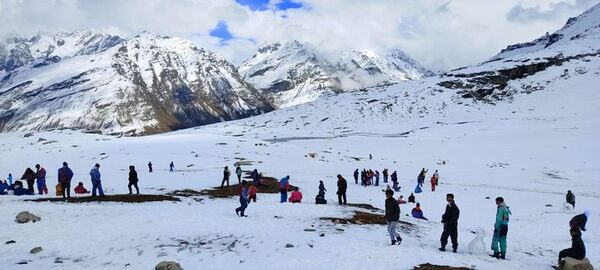Thursday, April 18, 2024

As summer heats up in India, the inbound travel market witnesses a significant surge, with Indian tourists flocking to the cooler climes of Himalayan hill stations. Destinations like Shimla, Manali, Darjeeling, and Leh become prime hot-spots, offering respite from the oppressive heat of the plains. Families, adventure seekers, and honeymooners are drawn to the scenic beauty, cultural richness, and the myriad of activities these mountains offer, from trekking to heritage tours. This seasonal migration not only revitalizes local economies but also underscores the enduring appeal of the Himalayas as an ideal summer retreat for domestic travelers.
This time of year marks the beginning of the peak travel season to some of India’s most revered mountainous destinations such as Shimla, Jammu and Kashmir, Sikkim, and Arunachal Pradesh.
The Lure of the Himalayas
The Himalayas, with their majestic peaks, lush green landscapes, and vibrant cultural heritage, offer a refreshing respite from the sweltering heat that grips much of India during the summer months. As the mercury rises, so does the influx of tourists to these high-altitude havens, seeking not only cooler weather but also the peace and tranquility that these regions are known for.
Shimla: The Queen of Hills
Shimla, fondly referred to as the “Queen of Hills,” is a top choice for many. This quaint hill station, once the summer capital of British India, continues to charm visitors with its colonial architecture, pedestrian-friendly Mall Road, and the panoramic views from the ridge. Families, honeymooners, and solo travelers alike flock to Shimla to enjoy its cool climate, engaging activities like trekking and heritage walks, and its famous toy train journey which is a UNESCO World Heritage site.
Jammu and Kashmir: Heaven on Earth
Jammu and Kashmir, often described as ‘Paradise on Earth,’ attracts travelers with its breathtaking beauty. The region offers a plethora of experiences, from boating on the crystalline Dal Lake in Srinagar and exploring the lush meadows of Gulmarg to the vibrant tulip gardens that bloom vividly in the spring. The recent years have seen a significant boost in tourism infrastructure, making the region more accessible and tourist-friendly despite its complex geopolitical nuances.
Sikkim: The Organic State
Sikkim, India’s first fully organic state, is another gem in the northeastern part of India. Known for its biodiversity, Sikkim is home to the enchanting Kanchenjunga, the third highest peak in the world. Visitors to Sikkim can indulge in a range of activities from trekking in the pristine valleys, visiting Buddhist monasteries like Rumtek and Pemayangtse, and exploring the vibrant local culture and cuisine. The state’s commitment to sustainability makes it an appealing destination for eco-conscious travelers.
Arunachal Pradesh: The Land of Dawn-Lit Mountains
Arunachal Pradesh, referred to as the ‘Land of Dawn-Lit Mountains’, offers an off-the-beaten-path experience for those looking to explore untouched natural beauty and rich tribal culture. It’s a place where one can traverse through the lush rainforests, visit ancient sites like the Tawang Monastery, and partake in local festivals that are a riot of color and traditional music. The state’s remote beauty makes it a perfect getaway for adventure seekers and those looking to disconnect and rejuvenate.

Tourism and Economy
The surge in tourism during the summer months is a significant economic booster for these regions. It not only supports local businesses but also promotes sustainable tourism practices that are crucial for preserving the unique ecosystems and cultural heritage of the Himalayas. Local governments and tourism departments are increasingly investing in improving infrastructure, ensuring safety protocols, and promoting responsible tourism to support the influx of visitors while maintaining the ecological balance.
Challenges and Opportunities
Despite the popularity, tourism in these regions faces its set of challenges. The fragile ecosystems of the Himalayas are susceptible to the pressures of over-tourism, which can lead to environmental degradation if not managed properly. Hence, there is a growing emphasis on promoting eco-tourism and educating tourists about the importance of preserving the natural and cultural environments they are visiting.
Preparations for Travel
Travelers planning to visit these destinations should prepare for varying weather conditions and be aware of the environmental impact of their activities. Packing light, using eco-friendly products, respecting local customs, and adhering to designated trails and guidelines are some ways tourists can contribute to sustainable tourism.
The summer travel season in India is a wonderful time to explore the Himalayan regions, offering an escape from the heat and a chance to immerse oneself in nature and culture. As these destinations continue to attract tourists, the balance between welcoming visitors and preserving the natural beauty will dictate the future of tourism in these pristine landscapes. For now, the mountains call, and it is up to the visitors to answer that call responsibly, ensuring these landscapes remain unspoiled for generations to come.
Tags: Darjeeling, India, Manali, SHimla
Tuesday, April 30, 2024
Tuesday, April 30, 2024
Tuesday, April 30, 2024
Tuesday, April 30, 2024
Tuesday, April 30, 2024
Tuesday, April 30, 2024
Tuesday, April 30, 2024